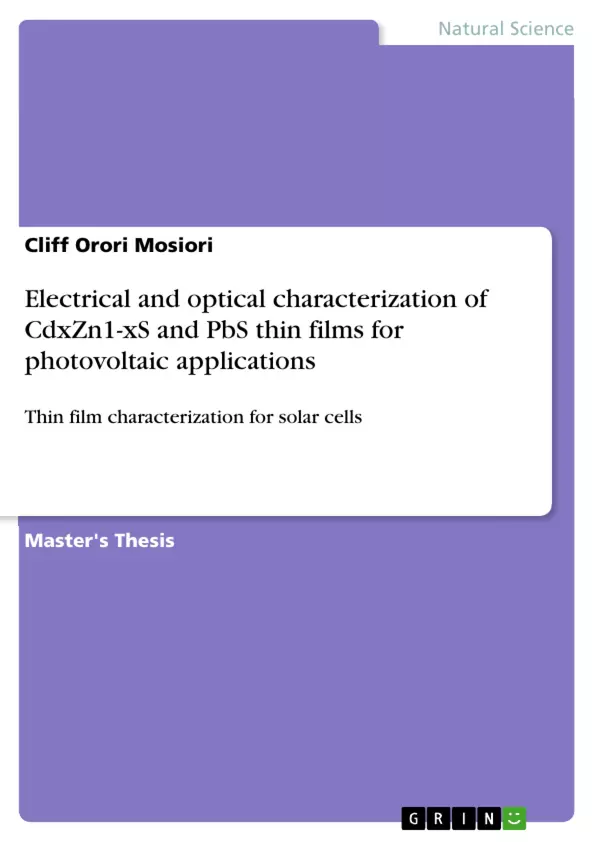In this research an n-type CdxZn1-xS and p-type PbS thin films were optimised for solar cell applications employing chemical bath deposition technique. The thin films were prepared using thiourea and nitrates of cadmium, zinc and lead. Deposition of optimised CdxZn1-xS was done by CBD at 820 C and in alkaline conditions while that of PbS was done at room temperature and both films at normal atmospheric pressure utilizing aqueous conditions. This study concentrated on optimising optical and electrical characterization of the films. Optical constant suitable for photovoltaic applications were sort for and for this purpose a UV VIS IR spectrophotometer 3700 DUV was utilised while the electrical properties were investigated using a four point probe connected to a Keithley 2400 source meter interfaced with computer. The optical band gap of the as deposited CdxZn1-xS films varied from 2.47eV (x =0.6) to 2.72 eV (x =1.0), and transmittance above 79% in the VIS - NIR region for the concentration range of x = 0.6 to 1.0, that is, the band gap increased with increasing Zn concentration of the alloy and Cd06Zn0.4S sample showed the widest band gap. It was obtained that the presence of zinc increased optical band gap. The average extinction coefficients for the as deposited CdxZn1-xS samples were very low revealing that they absorb very little radiation hence a good window layer material. As measured by the four point probe connected to a Keithley 2400 source meter, electrical resistivity increased with increase in Zn in the bath in CdxZn1-xS and a resistivity range of 9.5×101 – 1.22× 102 Ω-cm was obtained. These properties are appropriate for window layers used for photovoltaic cell applications. PbS thin films had a band gap of 0.89 eV and a transmittance of below 55% appropriate for absorber layers of photovoltaic cells and a resistivity range of 6.78 × 103 to 1.26 × 104 Ω-cm. The fabricated photovoltaic cell had a short circuit current, Isc = 0.031 A, open voltage, Voc = 0.37V, efficiency, η = 0.9% and a fill factor, FF = 0.66 implying that the two materials are appropriate for photovoltaic applications especially in the VIS and IR light spectrum.
Inhaltsverzeichnis (Table of Contents)
- CHAPTER ONE
- INTRODUCTION
- 1.1 Background of the study
- 1.2 Problem statement for the study
- 1.3 Objectives
- 1.3.1 Main objective
- 1.3.2 Specific objectives
- 1.4 Rationale of the study
- 1.5 Structure of thesis
- CHAPTER TWO
- LITERATURE REVIEW
- 2.1 Survey on Cadmium Sulphide (CdS) thin films
- 2.1.1 Electrical properties of CdS thin films
- 2.1.2 Optical properties of CdS thin films
- 2.2 Survey on lead sulphide (PbS) thin films
- 2.3 CdS-PbS based photovoltaic Cells
- CHAPTER THREE
- THEORETICAL CONSIDERATIONS
- 3.1 Semiconductor thin films
- 3.2 Energy bands in solids
- 3.3 Energy band structure in semiconductors
- 3.3.1 Intrinsic semiconductors
- 3.3.2 Extrinsic Semiconductors
- 3.4 Semiconductor transport carriers
- 3.5 Optical phenomena in thin films
- 3.5.1 Photoconductivity in thin films
- 3.6 Thin film applications
- 3.6.1 The p-n junction
- 3.6.2 Photovoltaic cells
- 3.6.2.2 Photovoltaic cell operation
- 3.7 Strengths and limitation of thin films for photovoltaic cells
- 3.8 Thin film deposition techniques
- 3.8.1 Chemical Deposition Techniques
Zielsetzung und Themenschwerpunkte (Objectives and Key Themes)
This thesis investigates the electrical and optical properties of CdxZn1-xS and PbS thin films for photovoltaic applications. The primary objective is to study the characteristics of these materials for their potential use in solar cell development.- Characterizing the electrical and optical properties of CdxZn1-xS and PbS thin films.
- Evaluating the potential of these materials for use in photovoltaic devices.
- Examining the influence of deposition parameters on the properties of the thin films.
- Exploring the effectiveness of CdS-PbS based photovoltaic cells.
- Discussing the advantages and disadvantages of using thin films for photovoltaic applications.
Zusammenfassung der Kapitel (Chapter Summaries)
- Chapter 1: Introduction introduces the background of the study, problem statement, objectives, rationale, and thesis structure. It establishes the context for researching the potential of CdxZn1-xS and PbS thin films in photovoltaic applications.
- Chapter 2: Literature Review presents an overview of the existing research on CdS and PbS thin films, focusing on their electrical and optical properties, as well as their applications in photovoltaic cells. This chapter provides a foundation for the research by summarizing the current knowledge in the field.
- Chapter 3: Theoretical Considerations explores the theoretical background behind semiconductor thin films, focusing on concepts like energy bands, semiconductor transport carriers, and optical phenomena in thin films. It discusses the principles underlying the operation of photovoltaic cells, including the p-n junction and photovoltaic cell operation. Finally, the chapter reviews strengths and limitations of using thin films for photovoltaic applications and examines various thin film deposition techniques, specifically chemical deposition techniques.
Schlüsselwörter (Keywords)
This research focuses on the characterization of CdxZn1-xS and PbS thin films for their potential application in photovoltaic devices. Key themes include electrical and optical properties of thin films, deposition techniques, photovoltaic cell operation, and the advantages and disadvantages of using thin films for solar energy conversion.- Citation du texte
- Cliff Orori Mosiori (Auteur), 2011, Electrical and optical characterization of CdxZn1-xS and PbS thin films for photovoltaic applications, Munich, GRIN Verlag, https://www.grin.com/document/278908



